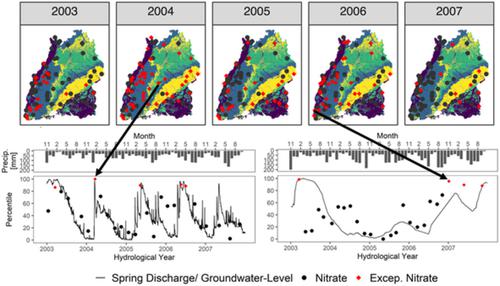当前位置:
X-MOL 学术
›
Hydrol. Process.
›
论文详情
Our official English website, www.x-mol.net, welcomes your
feedback! (Note: you will need to create a separate account there.)
Post-drought increase in regional-scale groundwater nitrate in southwest Germany
Hydrological Processes ( IF 2.8 ) Pub Date : 2021-07-11 , DOI: 10.1002/hyp.14307 Karuna Jutglar 1, 2 , Jost Hellwig 2 , Michael Stoelzle 2 , Jens Lange 1
Hydrological Processes ( IF 2.8 ) Pub Date : 2021-07-11 , DOI: 10.1002/hyp.14307 Karuna Jutglar 1, 2 , Jost Hellwig 2 , Michael Stoelzle 2 , Jens Lange 1
Affiliation

|
Elevated nitrate concentrations in groundwater are a common challenge for water management. One important factor in this context is higher frequencies and intensities of wet-dry cycles that may cause increased nitrate concentrations in groundwater due to nitrate flushes after drought termination. Yet systematic studies on regional-scale impacts of droughts on groundwater nitrate concentrations are missing so far. Here we analyzed time series of 44 shallow groundwater wells and 41 springs all across the German Federal State Baden-Wuerttemberg from 2000 to 2018 to characterize patterns of post-drought nitrate increase in groundwater. In general, half of the exceptional nitrate concentrations, which exceeded the 80th percentile of long-term nitrate measurements, could be related to droughts in the research timeframe. The 2003 drought event stood out in terms of drought severity and post-drought nitrate concentration increases in our data. The great majority (91%) of all monitoring sites showed at least one exceptionally high nitrate concentration in the 4 years following the 2003 drought event. Springs were mainly located in forests of steep low mountain ranges and wells in cropland of flat river valleys. Therefore, delay times between drought intensity and nitrate concentration increases as well as magnitudes of nitrate concentration increase were diverse among wells and springs. We derived two distinct nitrate response patterns: (i) nitrate increases immediately following drought events (more common for springs and fractured rock aquifers) and (ii) delayed nitrate increases (more common for wells and porous aquifers). Springs generally showed quicker (median of 101 days) but weaker (median of +1.3 mg/L) post-drought nitrate increases than wells (185 days, +3.4 mg/L). Only few sites exhibited no post-drought nitrate increase and post-drought mean-nitrate concentrations of groundwater reservoirs were extraordinarily high in 2006. Overall, we demonstrate that post-drought nitrate increase in groundwater is omnipresent, while different landscapes and hydrogeological characteristics create a diverse regional pattern. As severe droughts become more frequent in a changing climate, post-drought nitrate increase may intensify problems regarding water quality and supply.
中文翻译:

德国西南部区域尺度地下水硝酸盐的干旱后增加
地下水中硝酸盐浓度升高是水资源管理的一个常见挑战。在这方面的一个重要因素是干湿循环的频率和强度更高,这可能会导致由于干旱终止后硝酸盐冲刷而导致地下水中硝酸盐浓度增加。然而,到目前为止,还缺乏关于干旱对地下水硝酸盐浓度的区域尺度影响的系统研究。在这里,我们分析了 2000 年至 2018 年德国联邦巴登-符腾堡州 44 个浅层地下水井和 41 个泉水的时间序列,以表征干旱后地下水中硝酸盐增加的模式。一般来说,超过长期硝酸盐测量值 80% 的异常硝酸盐浓度的一半可能与研究时间范围内的干旱有关。在我们的数据中,2003 年干旱事件在干旱严重程度和干旱后硝酸盐浓度增加方面表现突出。在 2003 年干旱事件之后的 4 年中,所有监测点中的绝大多数 (91%) 显示出至少一个异常高的硝酸盐浓度。泉水主要分布在陡峭低山的森林和平坦河谷农田的水井中。因此,干旱强度和硝酸盐浓度增加之间的延迟时间以及硝酸盐浓度增加的幅度在井和泉水之间是不同的。我们得出了两种不同的硝酸盐响应模式:(i) 干旱事件后硝酸盐立即增加(更常见于泉水和断裂的岩石含水层)和 (ii) 延迟的硝酸盐增加(更常见于井和多孔含水层)。与井(185 天,+3.4 mg/L)相比,泉水在干旱后的硝酸盐增加速度通常更快(中位数为 101 天)但较弱(中位数为 +1.3 mg/L)。只有少数地点没有表现出干旱后硝酸盐的增加,而且 2006 年地下水库的干旱后平均硝酸盐浓度异常高。多样的地域格局。随着气候变化导致严重干旱变得更加频繁,干旱后硝酸盐的增加可能会加剧有关水质和供应的问题。只有少数地点没有表现出干旱后硝酸盐的增加,而且 2006 年地下水库的干旱后平均硝酸盐浓度异常高。多样的地域格局。随着气候变化导致严重干旱变得更加频繁,干旱后硝酸盐的增加可能会加剧有关水质和供应的问题。只有少数地点没有表现出干旱后硝酸盐的增加,而且 2006 年地下水库的干旱后平均硝酸盐浓度异常高。多样的地域格局。随着气候变化导致严重干旱变得更加频繁,干旱后硝酸盐的增加可能会加剧有关水质和供应的问题。
更新日期:2021-08-07
中文翻译:

德国西南部区域尺度地下水硝酸盐的干旱后增加
地下水中硝酸盐浓度升高是水资源管理的一个常见挑战。在这方面的一个重要因素是干湿循环的频率和强度更高,这可能会导致由于干旱终止后硝酸盐冲刷而导致地下水中硝酸盐浓度增加。然而,到目前为止,还缺乏关于干旱对地下水硝酸盐浓度的区域尺度影响的系统研究。在这里,我们分析了 2000 年至 2018 年德国联邦巴登-符腾堡州 44 个浅层地下水井和 41 个泉水的时间序列,以表征干旱后地下水中硝酸盐增加的模式。一般来说,超过长期硝酸盐测量值 80% 的异常硝酸盐浓度的一半可能与研究时间范围内的干旱有关。在我们的数据中,2003 年干旱事件在干旱严重程度和干旱后硝酸盐浓度增加方面表现突出。在 2003 年干旱事件之后的 4 年中,所有监测点中的绝大多数 (91%) 显示出至少一个异常高的硝酸盐浓度。泉水主要分布在陡峭低山的森林和平坦河谷农田的水井中。因此,干旱强度和硝酸盐浓度增加之间的延迟时间以及硝酸盐浓度增加的幅度在井和泉水之间是不同的。我们得出了两种不同的硝酸盐响应模式:(i) 干旱事件后硝酸盐立即增加(更常见于泉水和断裂的岩石含水层)和 (ii) 延迟的硝酸盐增加(更常见于井和多孔含水层)。与井(185 天,+3.4 mg/L)相比,泉水在干旱后的硝酸盐增加速度通常更快(中位数为 101 天)但较弱(中位数为 +1.3 mg/L)。只有少数地点没有表现出干旱后硝酸盐的增加,而且 2006 年地下水库的干旱后平均硝酸盐浓度异常高。多样的地域格局。随着气候变化导致严重干旱变得更加频繁,干旱后硝酸盐的增加可能会加剧有关水质和供应的问题。只有少数地点没有表现出干旱后硝酸盐的增加,而且 2006 年地下水库的干旱后平均硝酸盐浓度异常高。多样的地域格局。随着气候变化导致严重干旱变得更加频繁,干旱后硝酸盐的增加可能会加剧有关水质和供应的问题。只有少数地点没有表现出干旱后硝酸盐的增加,而且 2006 年地下水库的干旱后平均硝酸盐浓度异常高。多样的地域格局。随着气候变化导致严重干旱变得更加频繁,干旱后硝酸盐的增加可能会加剧有关水质和供应的问题。











































 京公网安备 11010802027423号
京公网安备 11010802027423号